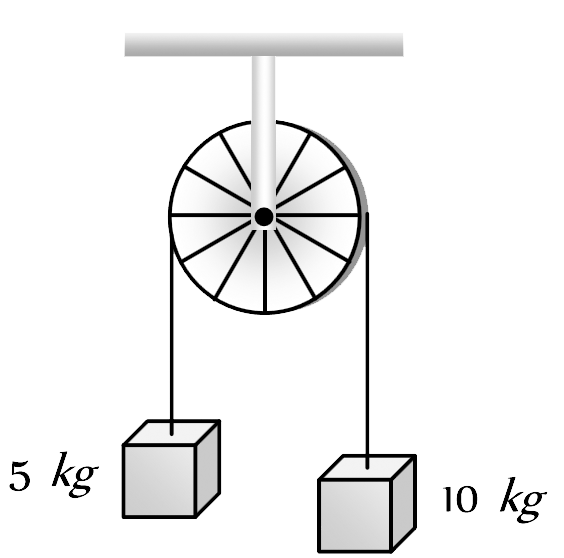A body A mass m1 exerts a force on another body B of mass m2 . If the acceleration of B be a2 , then the acceleration (in magnitude) of A is Solution in Gujrati
Zero
m2a2/m1
m1a2/m2
a2
The correct Answer is:B
F=m2a2=m1a1
∴a1=m2m1a2
Topper's Solved these Questions
- NEWTONS LAWS OF MOTIONBOOK - ALLEN CHAPTER - NEWTONS LAWS OF MOTIONEXERCISE - EXERCISE-III
28 Videos
- NEWTONS LAWS OF MOTIONBOOK - ALLEN CHAPTER - NEWTONS LAWS OF MOTIONEXERCISE - EXERCISE-I
52 Videos
- NEWTON'S LAWS OF MOTION & FRICTIONBOOK - ALLEN CHAPTER - NEWTON'S LAWS OF MOTION & FRICTIONEXERCISE - EXERCISE (JA)
4 Videos
- RACEBOOK - ALLEN CHAPTER - RACEEXERCISE - Basic Maths (Wave Motion & Dopplers Effect) (Stationary waves & doppler effect, beats)
25 Videos
Similar Questions
Assertion: The driver in a vechicle moving with a constant speed on a straight road is in a non-inertial frame of referance.
Reason: A reference frame in which Newton's laws of motion are applicable is non-inertial.
View SolutionUSS 150) Two masses of 5 kg and 10 kg are connected to a pulley as shown. What will be the acceleration of the system (g= acceleration due to gravity)

View SolutionA piece of wire is bent in the shape of a parabola y=kx2 (y-axis vertical) with a bead of mass m on it. The bead can slide on the wire without friction. It stays at the lowest point of the parabola when the wire is at rest. The wire is now accelerated parallel to the x-axis with a constant acceleration a. The distance of the new equilibrium position of the bead, where the bead can stay at rest with respect to the wire, from the y-axis is:
View SolutionThe frequency of a radar is 780 MHz. After getting reflected from an approaching aeroplane, the apparent frequency is more than the actual frequency by 2.6 kHz. The aeroplane has a speed of
View SolutionFigure shows a block of mass m_(1) sliding on a block of mass m_(2) , with m_(1) gt m_(2) . Find the (a) acceleration of each block (b) tension in the string (c ) force exerted by m_(1) on m_(2) . ltbr> (d) force exerted by m_(2) on the incline.
View SolutionA body A mass m_(1) exerts a force on another body B of mass m_(2) . If the acceleration of B be a_(2) , then the acceleration (in magnitude) of A is
View SolutionA force produces an acceleration of 4m//s^(2) in a body of m_(1)kg in another body of mass m_(2)kg If the same force is applied to (m_(1) + m_(2)) then the acceleration will be
View Solution(a) shows a block of mass m_(1) sliding on a block of mass m_(2) , with m_(1) gt m_(2) . Find (a) the acceleration of each block, (b) tension in the string, (c) force exerted by m_(1) on m_(2) (d) force exerted by m_(2) on the incline
View SolutionA force produces an acceleration of 4ms−2 in a body of mass m1 and the same force produces an acceleration of 6ms−2 in another body oa mass m2. If the same force is applied to (m1+m2), then the acceleration will be
View SolutionIn the arrangement shown in fig the bodies have masses m_(0), m_(1) and m_(2) the friction is absent the masses of pulleys and the threads are negligible find the acceleration of the body m_(1)
View SolutionTwo blocks of masses m_(1) and m_(2) are connected by massless threads. The pulleys are massless and smooth if a_(1) is the magnitude value of acceleration of m_(1) and a_(2) is the magnitude value of acceleration of m_(2) find the ratio of a_(1)/a_(2)
View SolutionA force F appllied to a body(A)of mas m1 produces an acceleratioin of 4m/s2. If the same force F is applied to another body (B) of mass m2, then an acceleratiionof 10m/s2, produced in the body. A and B are the tied together and the same force is applied to the combined body. What is the acceleration of the system?
View SolutionTwo masses M1 and m2 are experiencing the same force where m1<m2 the ratio of their acceleration a1a2 is
View SolutionTwo masses M1 and m2 are experiencing the same force where m1<m2 the ratio of their acceleration a1a2 is
View SolutionTwo bodies A and B of masses m_(1) and m_(2) moving with velocities V_(1) and V_(2) respectively collide. If m_(2)gt m_(1) then the force exerted by B on A during the collision is
View SolutionTwo bodies A and B of masses m_(1) and m_(2) moving with velocities V_(1) and V_(2) respectively collide. If m_(2) gt _(1) then the force exerted by B on A during the collision is
View Solution
